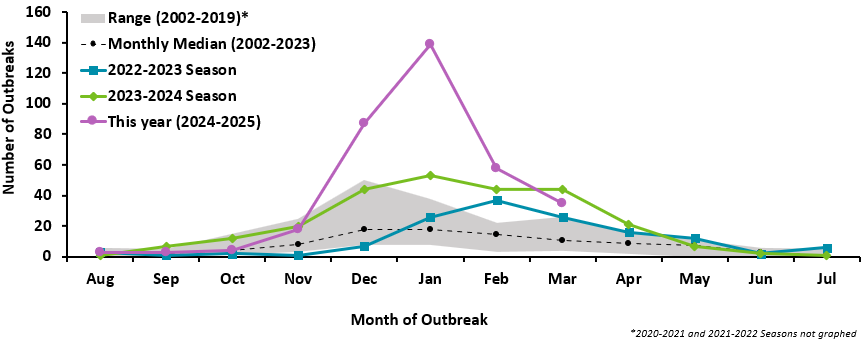2025 Public Health Laboratory Newsroom
Flurry of Norovirus Outbreaks Tackled by Minnesota Public Health Laboratory, Epidemiologists
During the winter of 2024-2025, Minnesota public health authorities recorded an unusually high number of norovirus outbreaks. (See Avoid norovirus over the holidays.) An average year will peak at around 20 norovirus outbreaks a month. In January 2025 alone, the Minnesota Department of Health (MDH) tracked more than 130 outbreaks, comprising more than 4,000 individual illnesses. Norovirus outbreaks occurred at a variety of settings, including long-term care facilities, restaurants, schools, and health care facilities.
Figure 1. Confirmed and Suspected Norovirus Outbreaks by Month, Minnesota, Aug. 2002-March 2025*

Norovirus is a disease that causes nausea, vomiting, diarrhea, and stomach cramps for a day or two. It is by far the most common type of foodborne illness. (Read more about norovirus infection and norovirus outbreaks.)
MDH epidemiologists and laboratorians work together on norovirus outbreak investigations. Epidemiology staff interview people who got sick and send out stool sample kits. (See how to submit a stool sample.) Stool specimens that are returned to the Minnesota Public Health Laboratory (PHL) are then tested by the staff of its Enterics unit, which deals with pathogens that cause vomiting and diarrhea. These tests confirm the outbreak etiology (i.e., which germ made people sick) and help staff learn more about different strains and subtypes that cause illness.
Stool specimens are first tested to determine if norovirus is in the sample. Next, if the sample is positive, the lab performs genetic analysis on the sample to determine which strain of norovirus is in the sample. See Figure 2(B) below.
Figure 2. Test results at MDH PHL for (A) stool samples positive for norovirus, and (B) norovirus sequencing

The lab submits their norovirus data to the national CaliciNet Surveillance Network and participates in the NoroSTAT Surveillance Network. These multi-state initiatives help scientists learn about norovirus outbreaks so we can prevent future illnesses.
This winter, the strain of norovirus called GII.17 [P17] caused many outbreaks in Minnesota and the United States. Read more at Norovirus Is Spiking: Why the Surge and How to Protect Yourself on the Association of Public Health Laboratories blog.
The Minnesota Public Health Laboratory also receives stool samples from a clinical laboratory in the Twin Cities area as part of the National Respiratory and Enteric Virus Surveillance System (NREVSS). The Public Health Laboratory performs norovirus testing and subtyping on those samples to learn about sporadic (not outbreak-associated) illnesses. In addition, the lab and over 10 clinical laboratories throughout Minnesota submit their aggregate (de-identified) norovirus testing data to NREVSS, which helps scientists understand norovirus activity levels.
The most important things you can do to prevent norovirus from spreading are:
- Wash your hands with soap and water for 20 seconds before preparing or eating foods, and after using the bathroom or changing diapers.
- Do not prepare food for others at all if you have been sick with vomiting or diarrhea in the last three days.
Norovirus outbreak prevention and response toolkits are available for long-term care facilities, schools, child care providers, and shelters at Gastrointestinal Outbreaks at Facilities.
Return to the 2025 Public Health Laboratory Newsroom.